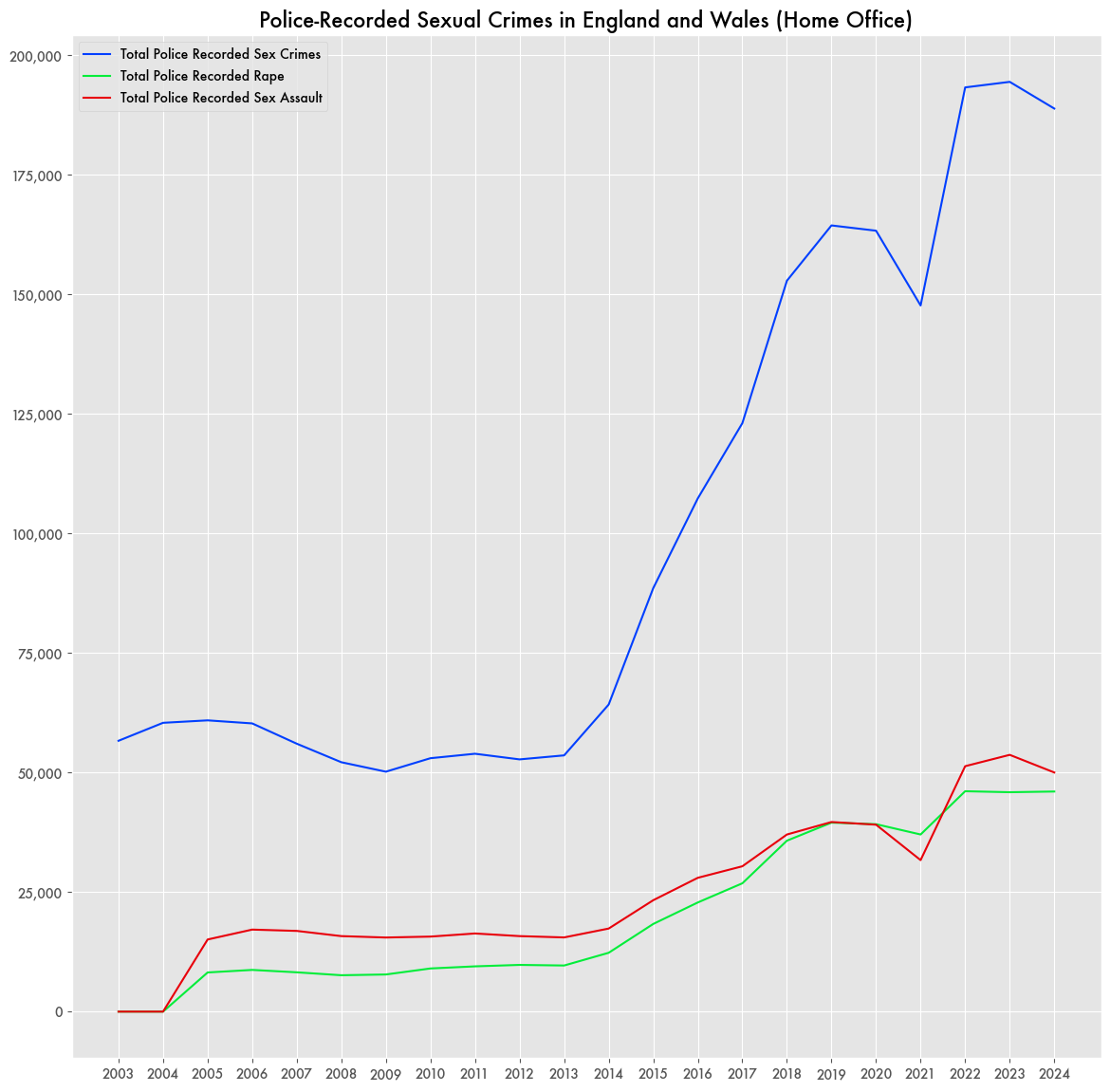England's Dubious Sexual Assault Epidemic
According to criminal offense data from the U.K. Home Office, the total number of recorded sexual crimes in England and Wales has quadrupled since 2012. There are now on order of almost 190,000 sex crimes detailed per year, up from around 53,000 twelve years ago.
The increase spans most categories of sex crimes but is largest in general sexual assault and rape. What was around 9,600 incidents of rape per year is now on the order of 46,000. With no major change in reporting standards since 2003, it would seem that the country is undergoing a massive sexual assault epidemic.
Potentially some of that is coming from multiple infractions surrounding the same crime. Sexual assaults parallel rape incidents so closely that they are commonly within 1 percent of each other in value.
Yet 46,000 reported rape incidents in a year alone is hard to fathom, and all other statistics show no sign of a sexual assault epidemic in England.
Little Change in Prosecutions
Despite the epidemic, relatively few are prosecuted. Between 2021 and 2022 only 4,049 rape cases—less than one-tenth of incidents—were referred for prosecution according to the Crown Prosecution Service (CPS). Only 2,223 of those led to a charge.
In general, the total number of prosecutions has not varied much over the last two decades. Between 2008 to 2015, the most prosecutions in a year was 4,536. At the time there were only around 18,338 reported incidents—putting the prosecution rate at a somewhat reasonable 25 percent.
Since then, supposedly there are now tens of thousands more incidents of rape each year with even fewer prosecutions, making the prosecution rate around 5 percent, as if the government were simply turning a blind eye to rampant villainy.
That potential sentiment was echoed by the Victim’s Commissioner—the governmental advocate for criminal victims—noting that the low number of prosecutions relative to incidents meant that justice was now effectively “a lottery.”
Little Change in Prevalence
Data on the prevalence of sexual assault—the rate per capita based on sample survey data—doesn’t show a growing epidemic based on numbers from the Crime Survey for England and Wales from the Office for National Statistics. While the percentage of those reporting some kind of sexual assault in the last year has gone up by a percentage point in the last ten years, it’s still below what it was ten years prior—3 percent in 2006. Nothing on the order of four times the prior rate as seen in the incident data.
But even that prevalence statistic also seems flawed. Even at the historic low of one percent the sexual assault rate would imply 470,000 reported sexual assaults a year based on the adult population of England being around 47 million—almost twice the already suspiciously high current total.
That would mean England has a similar amount of sexual assault to the United States despite having one-sixth the population.
CPS Versus MoJ Data
One potential source of the discrepancy is noted in CPS’ Violence Against Women and Girls (VAWG) report. It notes that CPS data includes a potential “rape flag” for incidents that may not eventually be prosecuted for rape but for another crime.
Whereas Ministry of Justice (MoJ) prosecution data is tracked by what infraction the crime is finally prosecuted as.
MoJ count a rape conviction only where the final conviction is specifically for rape. A case that initially started as a rape but was eventually convicted as an alternative offence (such as a lesser sexual assault) would count as a conviction under the lesser offence.
In contrast, CPS flagged data on rape convictions includes all convictions where an allegation of rape has been made regardless of the final offence convicted. The rape flag will remain in place, even if the decision is taken to charge an offence other than rape or where a rape charge is subsequently amended, to ensure application of the principles of the rape and sexual offence policy.
Sexual Crime Prosecutions and Keir Starmer
Before the sharp upswing in rape and sexual offense cases, Keir Starmer—now Prime Minister for Labor but previously head of CPS—was dogged by accusations that the office wasn’t prosecuting sexual offense cases, with conviction rates falling from 38.5 percent in 2008 to 33.8 percent in 2013.
But MoJ statistics showed an increase in conviction rates over that time period according to a Channel 4 investigation, and the discrepancy was related to the difference between how MoJ and CPS statistics.
Starmer’s successor at CPS, Alison Saunders, would also be criticized for how the office handled rape prosecutions, but related to disclosure of evidence to defense—nothing related to a lack of prosecutions.





